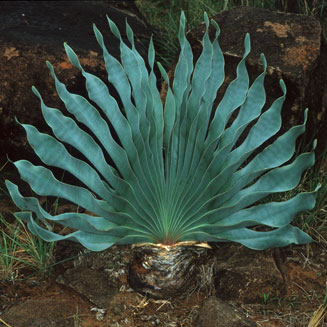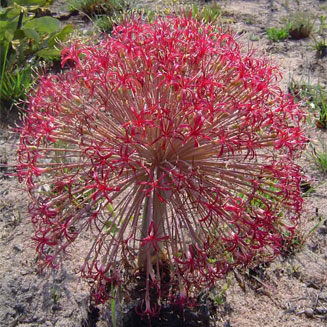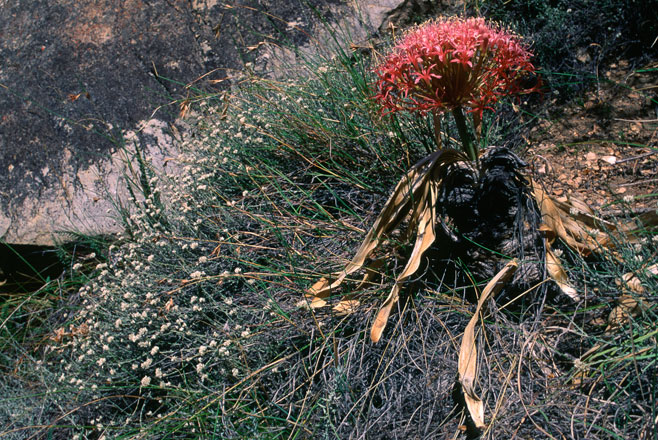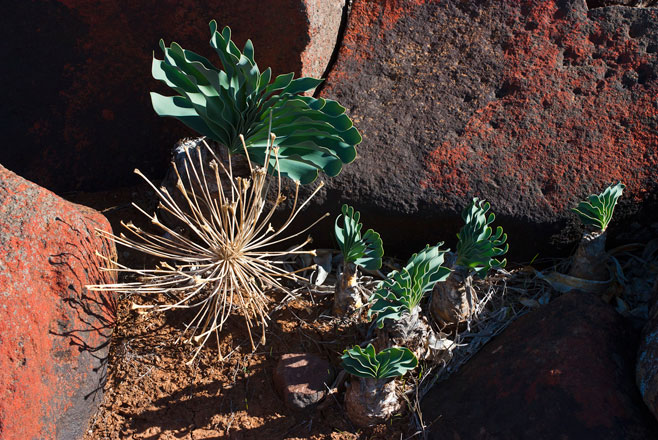Boophone disticha (Fan-leaved
boophone, Poison bulb, Sore-eye flower, Tumblehead)
Gifbol, Perdespook, Seerooglelie [Afrikaans];
kxutsana-ya-naha, leshoma, lesoma, motlatsisa [South Sotho]; incumbe,
siphahluka [Swazi]; incotho, incwadi [Xhosa, Zulu]; ibhade [Zulu]
Life
> eukaryotes >
Archaeoplastida >
Chloroplastida
>
Charophyta > Streptophytina > Plantae (land plants)
> Tracheophyta (vascular plants) > Euphyllophyta > Lignophyta (woody plants)
> Spermatophyta (seed plants) > Angiospermae (flowering
plants)
> Monocotyledons > Order: Asparagales
> Family: Amaryllidaceae > Boophone
 |
 |
|
Boophone disticha, South
Africa. [photo
H.G.
Robertson, Iziko ©] |
Boophone disticha near Rusape, Zimbabwe. [photo
Bart Wursten ©, Flora of Zimbabwe] |
 |
|
Boophone disticha flowering in summer in
the Montagu mountains, Western Cape, South Africa. [photo
Colin Paterson-Jones ©] |
 |
| Boophone disticha in leaf with a loose, dry
old flowerhead amongst dolerite boulders on the trekpad near
Nieuwoudtville on the Bokkeveld Escarpment, Northern Cape, South Africa. [photo
Colin Paterson-Jones ©] |
Distribution and habitat
Widespread in southern Africa where it is
found mainly on rocky slopes and flats. Distribution extends further
north into East Africa.
Life cycle
Information from Manning et al. (2002)
unless otherwise indicated.
- Has a large bulb ranging in size from 5 to 18 cm in
diameter.
- The leaves form in a distinctive fan shape that is
reminiscent of an open book . The Xhosa name for this plant,
incwadi, means 'book'. The leaves are usually dead at the
time of flowering.
- Flowers from September to March. The flowers are on the end
of long pedicels, together forming a ball shape.
- I have not come across any information on the pollinators of
Boophone disticha flowers.
- Once the fruit start developing, the pedicels grow further
forming a large ball-shaped structure. This eventually dries out
and the force of the wind breaks it off at the top of the scape.
It is blown around on the ground with seeds dislodged from their
capsules onto the ground. This form of wind-driven seed
dispersal is also found in the amaryllid genera Brunsvigia,
Crossyne, Hessea and Strumaria but in these the scape
breaks off at its base rather than at the top.
Chemistry
Information from Hutchings et al. (1996)
unless otherwise indicated.
Bulbs contain the following alkaloids:
- buphanamine. Evidente et al. (2009) have shown
in vitro that buphanamine shows strong anti-invasive
activity in cancer cells, meaning that it seems to stop
the cells from migrating from one type of tissue to another
(migrating from one tissue type to another is termed
metastasis). With this property and the fact that it is also
non-toxic to cells, even at high doses, makes it a hopeful
candidate as a cancer-reducing drug. In addition, there is
evidence (Neergaard et al. 2009) that buphanamine binds
to the serotonin transporter (SERT), which is a membrane protein
that transports the neurotransmitter serotonin from synaptic
spaces into presynaptic neurons. Thus, by binding with this
protein, buphanamine is prolonging the presence and effect of
serotonin in the synapse. This is the mechanism used by
selective serotonin re-uptake inhibitor (SSRI) anti-depressants.
- buphanidrine. Like buphanamine, also binds to the
serotonin transporter (SERT) (Neergaard et al. 2009).
- buphanine. Causes dilation of the pupil; paralyses
salivary secretions; paralyses vagus nerve terminations in the
heart; causes death from respiratory failure.
- buphanisine. Like buphanamine, also binds to the
serotonin transporter (SERT) (Neergaard et al. 2009).
- buphanitine
- distichine
- haemanthamine
- haemanthine
- nerbowdine
- undulatine
The bulb also contains a small amount of
volatile oil containing:
- furfuraldehyde
- acetovanillone (4-hydroxy-3-methoxyacetophenone)
- chelidonic acid
- copper
- laevulose
- pentatriacontane
- a phytosterol
- a mixture of free and combined fatty acids
Uses
Toxic effects
The bulb contains poisonous alkaloids
including lycorine and buphanine (resembling hyoscine) and consumption
thereof can result in death.
Pictures and information in field guides
See KwaZulu-Natal Wildflowers by
Elsa Pooley p. 346; Wild
Flowers of the Highveld by Braam van Wyk and Sasa Malan p. 188; Southern
Overberg wild flowers by Penny Mustart et al. p. 68
Links
Publications
- Dyer, R.A. 1953. Boophone disticha. Flowering Plants
of Africa 29: pl. 1141.
- Evidente A., Kireev A.S., Jenkins A.R., Romero A.E.,
Steelant W.F.A., Van Slambrouck S., Kornienko A. 2009.
Biological evaluation of structurally diverse amaryllidaceae
alkaloids and their synthetic derivatives: discovery of novel
leads for anticancer drug design. Planta medica 75(5): 501-507.
- Neergaard J.S., Andersen J., Pedersen M.E., Stafford G.I.,
Van Staden J. and Jäger A.K. 2009. Alkaloids from Boophone
disticha with affinity to the serotonin transporter. South
African Journal of Botany 75(2): 371-374.
doi:10.1016/j.sajb.2009.02.173
|
